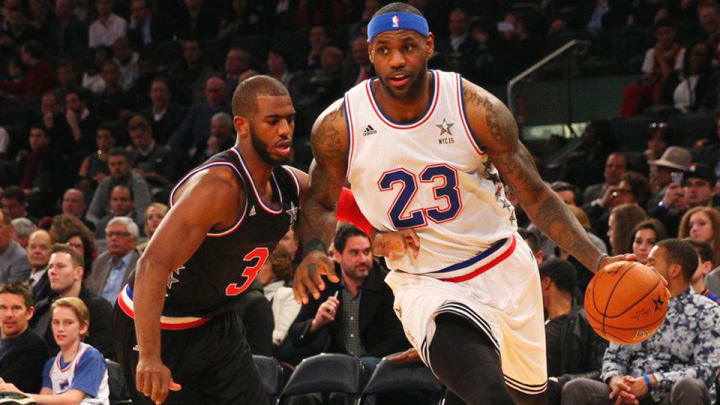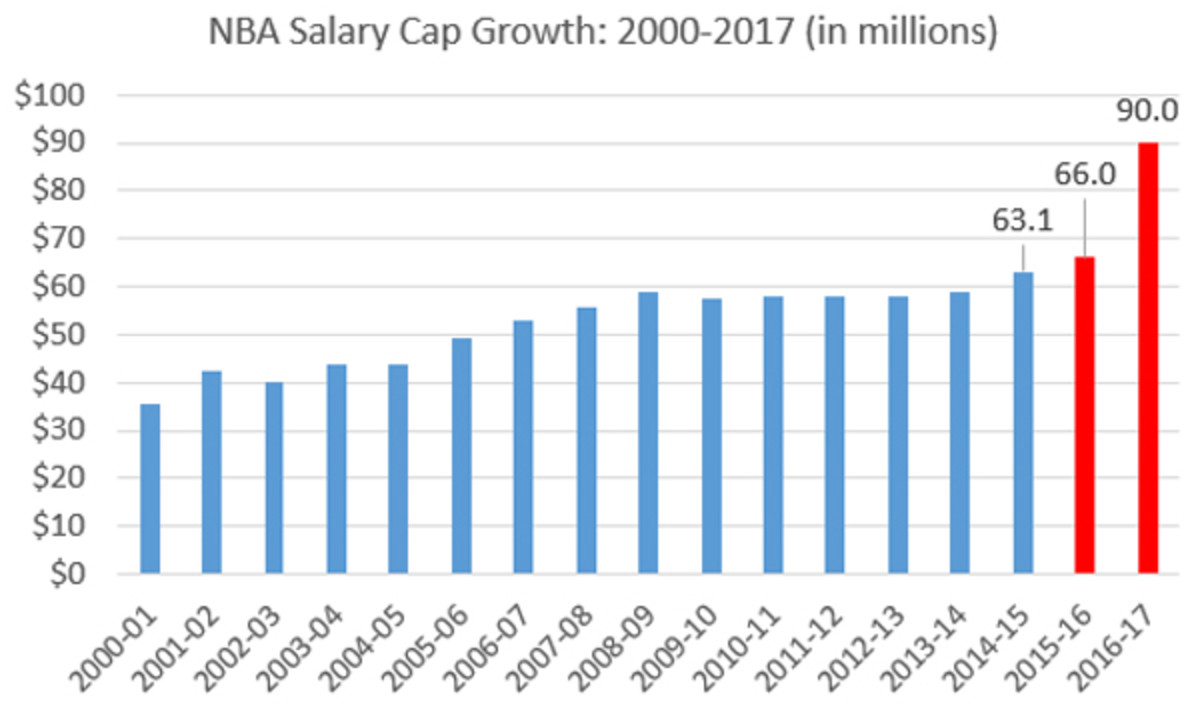NBPA rejects salary cap smoothing, setting stage for 2016 fireworks

The National Basketball Players Association (NBPA) has formally rejected the NBA's salary cap "smoothing" proposal, thereby setting the stage for a massive cap increase in 2016 and a potential labor battle in 2017.
The NBA announced the development, which was expected, in a statement released Wednesday. The proposal had been floated as a method for phasing in the increased revenues generated by the NBA's new media rights deals with ESPN and TNT, which were agreed to last October and are set to kick in for the 2016-17 season. Those deals, pegged at more than $2.6 billion per year, are expected to increase the league's salary cap by tens of millions of dollars.
NBA's new TV deal brings potential lockout, expansion into play
“Smoothing would have avoided a substantial Salary Cap spike in 2016-17," the league's statement read. "Under the league's smoothing approach, the salary shortfall resulting from more gradual cap increases would have been paid directly to the Players Association for distribution to all players, and thus the total compensation paid to players in any given season would not have been impacted.”
Rather than agreeing to gradually spread out the increase over the first few years of the new television rights deals and/or to preemptively phase in some of the increase next year, the NBPA, under the guidance of new executive director Michele Roberts, has opted for the direct approach. As a result, the salary cap, which is currently at $63.1 million, is expected to jump from roughly $66 to $68 million in 2015-16 to approximately $90 million in 2016-17.
• MORE NBA: SI's MVP roundtable | Mannix Mailbag | All-Bullseye team
The following chart shows the growth trend of the NBA's salary cap since 2000. Salary cap projections for 2015-16 and 2016-17 appear in red.

The anticipated $20-plus million growth in 2016-17 would be a record, by far. Indeed, the cap is currently projected to jump more in that single season than it has over the last decade combined.
NBA commissioner Adam Silver had been a public proponent of the smoothing system, but he told reporters at All-Star Weekend in New York last month that the league was prepared in the event that the NBPA rejected the proposal.
"When we negotiated the collective bargaining agreement [in 2011] we weren't then anticipating that this many years out that we would have this quick a jump in our television rights fees, but that's where the market has taken us," Silver said. "You deal with this situation as it's presented to you and I don't want to act like it's a terrible problem to have. We're thrilled that based on the interest in the NBA we're able to command these big increases in the television market and we will live with our deal."
Roberts had suggested publicly on multiple occasions that the NBPA was not in favor of the smoothing concept. A group of NBPA player representatives unanimously voted down the idea over All-Star Weekend.
"There is, and was, a concern about any proposal that results in limiting a player's ability to realize as much income as they can," Roberts said in February, according to Yahoo Sports.
To be clear, Roberts' concern is referencing money paid to individual players rather than total compensation to the players as a whole. Although the smoothing proposal would eventually have made the players whole once it was fully phased in, with the help of shortfall payments, not every current player will be under contract throughout the duration of the smoothing proposal. High-profile 2016 free agents like LeBron James and Kevin Durant will now be able to fully maximize the value of their next contracts rather than starting those deals at an artificially reduced figure. Similarly, marginal players, older players and those who might suffer serious injuries as the smoothing played out might have been taking a financial hit without sufficient delayed gratification to show for it personally. This depends on whether or not the shortfall payments covered their decreased earning power.
How LeBron James' new leadership role could impact the NBA's future
The "open the floodgates in 2016" approach sets up what could prove to be the wildest NBA offseason ever. The new TV deals are so lucrative that every team, including teams with payrolls that exceed the luxury tax currently, will be able to maneuver themselves towards open cap space by July 2016. That summer, more money is going to be burning more holes into more pockets than the league has ever seen.
Under the current system, possessing $15 million of cap space is considered a big deal, the type of flexibility needed to make a monster offer in free agency. Under the new system, teams could easily be sitting on $30 million, $40 million, $50 million or even $60 million of cap space. For big-market teams like the Lakers and Knicks who are trudging through an ugly present without a clear plan for the future, the NBA's new economy represents an unprecedented hope for immediate roster rebuilding. For more cost-conscious teams, the extra space will present a host of opportunities, whether that's increased flexibility to keep core pieces, to add proven role players to the bench, or to acquire assets by using salary cap space to take on salary. For stars hoping to team up and create a dynasty, the sky is the limit on dream scenarios. For stars simply looking to cash in every single penny on a max deal, the cash registers will be "Ca-ching" louder than ever before.
• MORE NBA: Roberts wants to make impact | Trends | Jenkins on the Hawks
In the meantime, 2015 free agents will need to decide whether they want to take the best deal available to them this summer or to delay their payday by 12 months in hopes of getting in on the 2016 party. A-listers like James and Kevin Love are reportedly planning to make full use of the 2016 system, while other players, fearing a potentially career-altering injury a la Wesley Matthews, might not be as willing to stomach that risk.
Hanging over the 2016 salary cap spike is the potential for either the NBA or the NBPA to opt out of the current labor deal in 2017. As noted last fall, Silver pushed for a hard salary cap during the 2011 negotiations, and this cap increase could help create the necessary conditions for implementing such a system. How many teams will be willing and legally able to build payrolls that push well over $90 million if their current tabs are a fraction of that number? The fewer high-spending outliers there are, the easier it would be to transition from a stiffened luxury tax system, which added repeater taxes and progressive tiers in 2011, to a true hard cap.
[daily_cut.NBA] Simultaneously, the NBPA leadership will almost certainly face increased pressure from its members to avoid any labor stoppage once some of its members get their taste of the 2016 rain-making. Who wants to sit out 20 games and miss multiple paychecks when total salaries just jumped by 30 to 40 percent? Roberts will have her hands full keeping all of her members on the same page when some portion of the group has already cashed in big and others are still waiting to reap the benefits. Will the group as a whole be able to hold a hard line against whatever structural changes or financial concessions the owners might desire? That remains to be seen.
The only certain takeaways from Wednesday's news are these: July 2016 will be total insanity, and the influx of cash will make the next round of labor negotiations that much more complicated.
